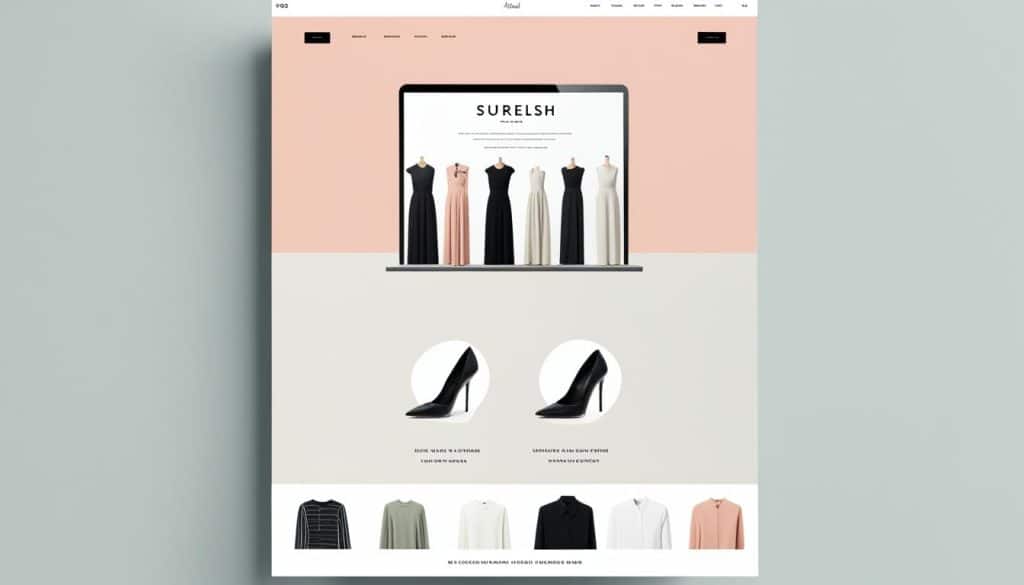Ever dreamed of starting your own clothing brand? Picture your designs on high street racks, adored by people across the UK. It’s a thrilling idea, but where do you begin?
This guide will walk you through the key steps to make your dream come true. We’ll cover improving your fashion design skills and creating a strong business plan. You’ll get the knowledge and strategies to start and grow your own fashion brand.
Get ready for an exciting journey packed with creativity, innovation, and a spirit of entrepreneurship. Whether you love streetwear, luxury fashion, or sustainable clothing, this guide will guide you through the competitive fashion world. You’ll learn to make your unique vision stand out. Prepare to turn your creativity into a successful business!
Key Takeaways:
- Starting a clothing line requires a combination of design skills and business acumen
- Developing a strong fashion brand involves honing your creativity and unique vision
- Creating a compelling business plan is crucial for launching a successful clothing brand
- Staying updated on fashion trends is essential to thrive in the industry
- Building a strong brand image and identity will set you apart from competitors
Develop Your Fashion Design Skills
Improving your fashion design skills is key to making a successful clothing brand. Whether you want to design elegant dresses or trendy streetwear, it’s crucial to develop your skills. This is the first step towards making your dream come true.
Formal fashion education can give you valuable knowledge and resources. But, it’s not the only way to succeed. Real-world experience and learning on the job are just as important. Fashion schools and design programs offer a great way to learn in a creative environment.
Consider joining top schools like Parsons or Central Saint Martins. Here, you can be part of a creative community and learn from experts.
If going to fashion school isn’t possible for you, there are other options. Fast-track programs and online courses let you learn at your own pace. They cover important design principles, how to make garments, fashion illustration, and more. These courses help you improve your skills while you keep up with work or family.
Don’t just stick to formal education. Dive into the fashion world. Keep up with trends, go to fashion shows, and check out exhibitions. This will inspire you from both famous designers and new talents.
Also, think about getting internships or apprenticeships with fashion brands or designers. This will give you real-world experience and teach you the industry’s secrets.
Fashion design skills grow with time through theory, practice, and creativity. Take every chance to improve your skills and challenge your imagination. By always working on your skills, you’ll be ready to make designs that stand out. This will help your clothing brand succeed.
Create a Clothing Business Plan
A clothing business plan is key to starting and growing your clothing line. It acts as a roadmap and attracts investors and partners. It outlines your vision, goals, and strategies, guiding your brand’s success.
When making your business plan, think about your target market first. This is the group of customers you want to reach. Knowing what they like, need, and buy helps you make products and market them well.
Then, define your brand identity. This includes your values, personality, and what makes your clothes special. It sets you apart from others and draws in your target market. Think about your style, quality, and the story behind your brand.
Also, outline your sales strategy. This covers how you’ll sell, set prices, and promote your products. Will you sell online or in stores? Will you work with boutiques or influencers? These decisions help shape your sales plan.
Don’t forget about the financial side. Look into costs for making, marketing, and running your business. Check out funding options like loans or crowdfunding. Make a financial forecast to set realistic goals.
A detailed business plan helps your brand and shows you’re ready to the world. It makes getting funding and partnerships easier and helps you tackle industry challenges.
So, invest time in a business plan that covers your target market, brand, and sales strategy. It will be a key tool in your fashion journey.
Follow Fashion Trends
It’s key to keep up with fashion trends to stay relevant in the industry. As a fashion entrepreneur, knowing the latest trends is crucial. But, just following every trend can make your brand blend in. It’s important to know what makes your brand stand out.
Understanding your target niche is vital for trend forecasting. Every brand has its own unique identity. By focusing on what makes your brand special, you can create a look that’s true to you.
Adding fashion trends to your collections should add value and make your brand more personal. Think about how you can make trends work for your customers. This way, you’ll connect better with your audience and be seen as a trendsetter in your niche.
Stay Updated with Fashion Publications, Influencers, and Industry Events
- Subscribe to fashion publications and blogs that feature up-to-date trend reports.
- Follow influential fashion bloggers and social media influencers who specialize in your target niche.
- Attend industry events, such as fashion weeks and trade shows, to gain firsthand insights into emerging trends.
By keeping up with fashion publications, influencers, and events, you can spot new trends early. This helps you add fresh, trendy items to your collections. Being proactive keeps your brand ahead of the competition.
Fashion trends change all the time. It’s important to stay informed to keep your brand relevant. Use trend forecasting to make your brand stand out. This way, you can create a fashion line that’s unique and desirable.
Build a Strong Brand

In the competitive clothing market, having a strong brand is key. It helps you stand out and build loyalty. A clear brand identity makes you different from others.
Start by defining your brand’s values and mission. Know what makes your clothes special. This will guide your brand’s message and where you fit in the market.
Visuals are crucial for a strong brand. Design a logo that shows your brand’s personality. Choose colors and typography that match your brand’s style and voice.
Getting your brand known is important. Use social media to connect with your audience. Share content that shows your brand’s values and style. Work with influencers and other brands to reach more people.
Don’t forget about real-life events like fashion shows and trade fairs. These are great for meeting customers and industry experts. They help spread the word about your brand.
Building loyalty means always offering great products and service. Provide excellent customer service to keep customers coming back. Listen to feedback to make your products better.
Focus on making your clothing brand strong. A clear identity, good marketing, and quality products will make you stand out. This approach will help your brand succeed in a tough market.
Design and Develop Your Clothing Line
Creating your clothing line is key to your fashion business’s success. It will show off your brand’s identity and vision. You can hire a skilled designer or work with one who gets your creative vision.
With a designer on your team, start the garment design process. This means making sketches and fashion illustrations for your collection. Your designer will make sure the designs fit your brand and target market.
After deciding on designs, it’s time for product development. This means making the sketches into real prototypes. Prototypes help check the quality, fit, and look of your clothes. Get feedback from fashion experts or potential customers to improve your prototypes.
Working together is important in garment development. Team up with pattern makers, manufacturers, and suppliers to make your clothes. Make sure to share your needs clearly and give detailed specs for the final products.
It’s vital to balance creativity with practicality. Designing unique and innovative clothes is key, but think about costs, materials, and how long it takes to make them too.
Key Steps for Designing and Developing a Clothing Line:
- Define your brand identity and vision.
- Hire a skilled garment designer or collaborate with one.
- Create sketches and fashion illustrations for your collection.
- Transform the sketches into physical prototypes.
- Solicit feedback and make necessary revisions.
- Collaborate closely with pattern makers, manufacturers, and suppliers.
- Ensure clear communication and detailed specifications.
- Maintain a balance between creativity and practicality.
Follow these steps to create a clothing line that reflects your brand and appeals to your audience. Stay true to your vision, listen to feedback, and keep refining your designs for a successful collection.
Source Fashion Fabrics or Design Your Own

Finding the right fashion fabrics is key to making your clothing line a success. The fabrics you pick affect the look, feel, and quality of your clothes. When looking for fabrics, think about quality, cost, and sustainability.
Look into various options and find fabric suppliers with a wide selection for your designs. Choose suppliers who focus on sustainable materials. This appeals to customers who want eco-friendly fashion. Using sustainable materials can draw in a market that cares about ethics and the planet.
If you want your brand to stand out, designing your own fabrics is a great idea. Use your brand’s vision and story for inspiration. Work with textile designers to make your unique fabrics. This way, you can have fabrics that match your brand perfectly and give your customers a special experience.
Choosing the right fabrics is crucial for your clothing line’s success. Using fashion fabrics that match your brand’s values and appeal to your audience is important. This can make a big difference in the competitive fashion world.
Whether you decide to buy fabrics or design them, make sure they fit your brand and appeal to your customers. By picking and using fashion fabrics wisely, you can make a clothing line that is unique and in demand.
Key points to remember when sourcing fashion fabrics or designing your own:
- Research different fabric options that align with your brand
- Consider factors like quality, cost, and sustainability
- Connect with fabric suppliers who prioritize sustainable materials
- Explore the possibility of designing your own fabrics
- Collaborate with textile designers to create unique fabric designs
Set Up Production and Manufacturing for Your Clothing Line
Setting up production and manufacturing is key to making your clothing line a reality. You can either produce in-house or work with partners. Either way, planning and attention to detail are vital for quality and ethical production.
Producing in-house means you control every step, from getting materials to the final product. It lets you keep a close eye on everything. But, it takes a lot of money for machines, space, and skilled workers.
Working with manufacturing partners can save you money and help you grow. They can make your production smoother and handle more orders. Look for partners with fashion experience and a good track record of quality.
Quality control is crucial, no matter your production method. Make sure every item meets your brand’s standards. Check materials, parts, and finished products carefully. Talk to your partners often to fix any quality issues and improve things.
Think about ethical production too. Pick partners who treat workers fairly and are good for the environment. Working with ethical makers matches your brand’s values and appeals to customers who want sustainable fashion.
Finding good manufacturing partners and keeping quality high is key to success. Focus on quality, ethics, and efficiency to build a strong base for your clothing line.
Get tips and advice from industry experts on setting up production and manufacturing for your clothing line in this image:
Build Pricing and Inventory Strategies for Your Clothing Business
Creating smart pricing and inventory plans is key to your clothing business’s financial success. By using clever pricing and managing your stock well, you can boost your profits and grow sustainably.
Start by doing a detailed cost check. This means figuring out the costs of making and selling your clothes, like materials, labor, production, marketing, and overheads. Knowing these costs helps you see what price you need to charge to make a profit.
With your costs clear, you can set the right prices for your market. Think about what customers want, what others charge, and how much they value your products. This approach lets you stand out in the market while staying profitable.
Good inventory management is also vital for cutting costs and streamlining your supply chain. Use systems to keep an eye on stock, analyze sales, and predict demand. This way, you can spot trends, avoid running out or having too much stock, and keep your inventory fresh.
Key Strategies for Pricing and Inventory Management:
- Regularly review and adjust your prices to align with market demands and fluctuations.
- Offer competitive pricing without compromising your profit margins.
- Implement pricing tiers or bundles to cater to different customer segments.
- Monitor stock levels and reorder thresholds to maintain optimal inventory levels.
- Utilize data analytics to forecast demand and optimize purchasing decisions.
- Establish strong relationships with suppliers to negotiate favorable pricing and terms.
Keep tweaking and improving your pricing and inventory plans to stay ahead in the market and increase profits. Always think about what your customers like, the latest trends, and your business aims when deciding on prices and stock levels.
Plan Your Collections Around Fashion Seasons

Planning your collections with fashion seasons is key in the fashion world. Keeping up with trend forecasting helps you match your designs with what’s coming next. This way, you meet the changing tastes of your customers.
Stay Ahead with Trend Forecasting
Trend forecasting lets you predict future fashion trends. Look at fashion magazines, go to fashion events, and follow top designers and brands. This gives you insights into the latest styles, colours, and fabrics for the next seasons.
Look at both big fashion trends and niche ones in your market. This keeps you relevant to your customers while fitting with the wider fashion scene.
Align with Color Trends
Colors are vital in fashion, setting moods and making a visual impact. Each season comes with its own color palette. Use color trend reports to pick the right hues for your collections. This makes sure your designs match the current fashion mood.
Consider Fabric Choices
Fabric choices match fashion seasons well. In summer, people like light, airy fabrics. In winter, they prefer thicker materials like wool and velvet. Choosing the right fabrics makes your collections more appealing and practical.
Cater to Customer Preferences
Knowing what your customers want is key. Do market research, look at customer feedback, and see what they buy. Make your collections fit their tastes and needs. This way, they’ll love and buy your designs.
Planning with fashion seasons keeps your designs fresh, wanted, and in style. Use trend forecasting, color trends, fabric choices, and customer insights to make collections that grab your audience’s attention. This will boost your clothing business’s success.
Pitch Your Clothing Line to Fashion Retailers
Working with fashion retailers is key to your clothing line’s success. By teaming up with well-known retailers, you can reach more people. To get their attention, you must have strong buyer presentations and sales pitches. These should show off what makes your brand special and why it’s worth their time.
When making your presentations, focus on what makes your clothes stand out. Talk about unique designs, quality materials, eco-friendly practices, or your brand’s story. Use pictures and videos to make your products look appealing and memorable.
Look for fashion retailers that match your brand and target market. Know what they sell, who buys from them, and what they stand for. This knowledge will help you make your presentations more relevant to them.
When you meet with retailers, talk about how working together can benefit both of you. Explain how your brand can add something new to their stores and bring in more customers. Show you understand their customers and how your clothes will appeal to them.
Building good relationships with buyers is important. Network at events, trade shows, and meetings where you can show off your designs. Talking to decision-makers and building trust can lead to great wholesale partnerships.
Be ready to talk about things like prices, how much they need to order, when they can get it, and how they’ll pay. Know what others in the industry charge to stay competitive. Mention any special offers you can give, like easy returns, exclusive deals, or marketing help.
The fashion world is tough, and not everyone will say yes right away. Use feedback from retailers to make your pitch better for next time. Staying determined and hardworking is essential for doing well in this field.
Build an Online Clothing Store

With e-commerce on the rise, having an online clothing store is key for fashion businesses. It lets you reach more customers and offers ease for shoppers. We’ll show you how to build and boost your online clothing store.
Choose the Right E-commerce Platform
Choosing the right e-commerce platform is vital for fashion businesses. Shopify is a top pick for its ease of use, many customization options, and smooth payment gateway integration.
Optimize Your Website for Success
Make your online store stand out by optimizing it. Focus on keyword research, meta tags, responsive design, and quick-loading pages. These steps help search engines find and rank your site better.
Implement Digital Marketing Strategies
Digital marketing is key to boosting your store’s traffic and sales. Use social media like Instagram, Facebook, and Pinterest to show off your products and connect with customers. Create content that speaks to your audience and drives sales. Think about paid social media ads to reach more people.
Also, use email marketing to keep customers coming back. Work with fashion influencers and bloggers to spread the word about your brand. A strong online presence is crucial for your store’s success.
Starting an online clothing store is thrilling but requires careful planning. Pick the right platform, optimize your site, and use digital marketing to draw in customers and increase sales. Keep up with the latest in website optimization and digital marketing to stay ahead.
Market Your Clothing Business
Marketing is key to promoting your clothing business and drawing in customers. A strong marketing plan can boost brand awareness, engage more customers, and increase sales. Here are some strategies to market your clothing business well:
1. Clothing Business Marketing
Make a detailed marketing plan that covers online and offline methods. Use social media like Instagram, Facebook, and Twitter to show off your clothes and talk to your audience. Share interesting content, like photos, videos, and blog posts, to grab attention and send people to your website or online shop.
Use SEO to make your website more visible in search engines. Do keyword research and make your website’s content, meta tags, and URLs better. This will help your business show up higher in search results, bringing in more visitors and potential customers.
2. Brand Promotion
Work with fashion influencers and brand ambassadors to get your brand noticed by more people. Pick influencers who share your brand’s values and target audience. You can work together on sponsored posts, giveaways, and product reviews. Influencer marketing can help build trust, credibility, and loyalty to your brand.
3. Influencer Collaborations
Working with influencers is a great way to promote your clothing business. Choose influencers with a big following and a strong impact in fashion. This could be fashion bloggers, stylists, models, or celebrities. By having your clothes featured on their platforms, you can reach a wider audience and get your brand out there.
4. Fashion Events
Join fashion events, trade shows, and exhibitions to show off your clothes and meet potential customers and retailers. These events help create excitement about your brand and get valuable feedback. Go to events in your clothing niche to keep up with trends and network with professionals in the fashion industry.
Using these marketing strategies can help you promote your clothing business well, increase brand awareness, and build a loyal customer base. Always check how your marketing is doing and tweak it to get better results and stay ahead of competitors.
Open a Retail Store, Launch a Pop-up, or Sell at Markets
Want to grow your clothing business offline? Think about opening a retail store, starting pop-up shops, or selling at markets. These options let you meet customers face-to-face, build loyalty, and boost sales.
Having a retail store means you have a permanent spot for customers to see your clothes. It’s a place where they can dive into your brand and have a special shopping experience. This can also draw in people walking by and connect you with locals.
Pop-up shops are perfect if you’re not ready for a long-term store. They’re temporary and can be in busy places or with other brands. This way, you reach new customers who might not know about your online store.
Selling at markets and events is another smart move. It lets you talk directly with potential buyers, get feedback, and make connections. With great displays, your market stall can stand out and draw people in.
Integrate an Omnichannel Strategy
Think about using an omnichannel strategy that mixes online and offline sales. Linking your stores, pop-ups, and market stalls with your website gives customers a smooth shopping journey. They can look at products online, try them on in-store, and buy through their favorite method.
This approach makes shopping easier for customers and gives you useful data. You can see what they like and how they shop across all channels. This helps you improve your sales plans. Plus, it makes your brand more consistent and loyal customers happier, as they interact with you in many ways.
Opening a store, starting pop-up shops, or selling at markets are great ways to grow your clothing business. They help you meet customers directly, spread the word about your brand, and increase sales. By using an omnichannel strategy, you can link your online and offline efforts for better reach and customer happiness.
Learn from the Pros
Learning and getting advice from experts is key to your clothing business’s success. By going to events, workshops, and seminars, you keep up with new trends and practices. These can make your designs better and boost your brand’s image.
Mentorship is also a great way to get valuable insights and advice. Work with seasoned fashion designers or business experts. They can help you overcome challenges and understand the industry better. Their knowledge can prevent costly errors and give you an edge over others.
Being part of fashion networks and communities lets you meet others who think like you. You can learn from their experiences and share your own. This way, you can broaden your views and find new ways to improve your design, marketing, and business skills.
The fashion world is always changing. Always be open to learning and improving yourself. Keep exploring and trying new things to stay ahead with the latest trends and methods. By mixing your creativity with industry knowledge, you can make a clothing line that really speaks to customers and makes your brand stand out in the fashion world.
















